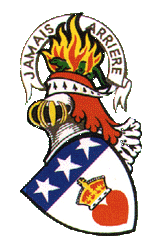This page is a stub.
You can help improve it. Apologies for the poor translation!
The territory of the City of Sarmato was derived from the
aggregation of the Scottish feud, the fellowships of Veratto,
Pontetidone and Agazzino, inhabited, then very populous.
The
documented history dates back to 1216 when the militia of Piacenza and
Milan gathered under its walls, waiting to make war on the pavement
enemies and in 1270 the fortress, then defended by the Pallastrelli
family, was attacked and seriously damaged by the militias of the Lord
of Bardi , Count Ubertino Landi, one of the leaders of the imperial
faction.
The Pallastrelli di Sarmato, whose story is related to
the tradition of S.Rocco and S.Gottardo, had to sell in 1363 and moved
to Portugal where they got honors and privileges and a descendant of
Gottardo Felipa Perestrello (actually Pallastrelli) married l Explorer
Cristoforo Colombo, discoverer of the Americas.
The fortress and
the rich feud of Sarmato then passed to the rich merchant Bartolomeo
Seccamelica, which was invested in 1376 by Galeazzo Visconti, then Lord
of Milan. To defend the fort of Sarmato Seccamelica had to undergo in
his manor a long siege of the Guelas faction Who captured him and
imprisoned him. His wife and all his sons were killed except one female,
Margherita.
Though married, despite belonging to a hostile
family of imperial power, the noble Giacomo Scotti, nephew of Alberto
Scotti "The Rich" Lord of Piacenza, bringing to this family the fief and
lands of Sarmato. Scotti's rule, and in particular Count Alberto Scotti,
was undermined in the first half of the 1900s at the Arcelli Fontana,
Counts of Val Tidone, and by the Milan Counts Verme, and with Luigi Dal
Verme held Castel San Giovanni .
From the second half
of the 14th century, the fief returned to the ownership of the Scotti-Douglas
accounts until 1819 when, with the death of the last heir - Countess
Luigi Scotti-Douglas da Sarmato - passed for female inheritance to the
accounts Zanardi Landi of Veano who still preserve it, and began a
gradual recovery and enhancement path.
Paolo Emilio Scotti,
Count of Sarmato, who was killed in 1585, was the father of Paolo
Antonio Scotti and brother of Carlo Scotti.
Paolo married Domitilla
Rangoni.
Domenico Maria Scotti Douglas, count of Sarmato (1751-1854), had the Scotti palace built in via San Siro in Piacenza
He was father of
Pietro Scotti Douglas, Conte di Sarmato
1792-1863 who married in 1799 as his 1st wife Teresa Costa (1801-1823}
parents of
Giovanni Battista Scotti Douglas, Conte di Sarmato 1819-1823
and
Giuseppina Scotti Douglas, who married Ranuzio Anguissola Scotti, Conte
di Podenzano 1808- (1)
Pietro Scotti Douglas, Conte
di Sarmato 1792-1863 also married as his 2nd wife Elena Trivulzio, Donna
1802-1868
parents of
Alberto Scotti Douglas, Conte di Sarmato (1826-1850) aged 24 years old
Countess Anna Anguissola Scotti, b. 1850, daughter of Count Ranuzio
Anguissola Scotti and Giuseppina Scotti, married Ubertino Landi and was
then known as Anna Landi di Chiavenna. She is a Douglas Scotti on her
mother's side (Giuseppina Scotti Douglas). While she had children with
her husband Ubertino, she later had an extramarital relationship with an
English correspondent which resulted in the birth of a daughter who was
raised in one of the family castles under the care of nuns, and later
adopted by a local family.
Countess Luigia Douglas Scotti d'Adda (Portrait above) was possibly the
wife of Luigi Douglas Scotti of Sarmato,
who was last of that line.
Notes:
1. The
visiting card is probably that of His Excellency Ranuccio Giuseppe
Anguissola Douglas Scotti, Count and Lord of Rivergaro. Giuseppina
Anguissola Scotti (born Scotti Douglas dei Conti di Sarmato) married
Ranuccio Anguissola Scotti. They had one daughter: Anna Landi di
Chiavenna (born Anguissola Scotti). (Rivergaro is a commune in the
Province of Piacenza.)
2. Referring to Torre Fornello, an important manor residence,
especially during the months of the harvest:- 'In 1682, Luigia Scotti
Douglas, descendant of the noble Scottish family and widow of Count
Zanardi Landi, Grand Duke of Tuscany, left the property to her
daughter'.
3. Built in ten years starting from 1772, Palazzo
Scotti di Sarmato has a simple external elevation with three orders of
twenty-five windows with an unusual decoration in relief on the
tympanums of the first floor, representing busts of naturalistic motifs,
warriors, ladies and masks. The portal is surmounted by the great Scotti
noble shield and shielded by a wonderful wrought iron gate in two spiral
panels separated by two horizontal neoclassical frames with a central
coat of arms. The internal articulation, on the other hand, is
particularly interesting, with the vast courtyard bordered by the side
wings extending towards the large garden that overlooks the Stradone
Farnese.
The conception of the project could be traced back to the
famous architect from Romagna Cosimo Morelli, even if the documents
mention only the master builder Giuseppe Marioni, due to the evident
stylistic similarities with Palazzo Anguissola di Grazzano, in
particular, in the layout of the courtyard punctuated by full arches
centre and its internal faηade, punctuated by doors, windows and
pilasters of neoclassical style.
4. Illustrious personalities
stayed in Palazzo Scotti di Sarmato such as Napoleon who arrived in
Piacenza as a conqueror during the crossing of the Po by his army and
Pope Pius VII who crowned Napoleon.
See also:
The
Douglas Scotti families of Fombio and Sarmato tree
Douglas Scotti of Fombio
Douglas Scotti origins
Scotti properties in the Piacenza area (External site)
Castello della Bastardina
Scotti Douglas
and the
Condottieri di Ventura
Sarmato, village and castle
For more on the Douglas Scotti families of Italy, see our
Italy portal.
|


